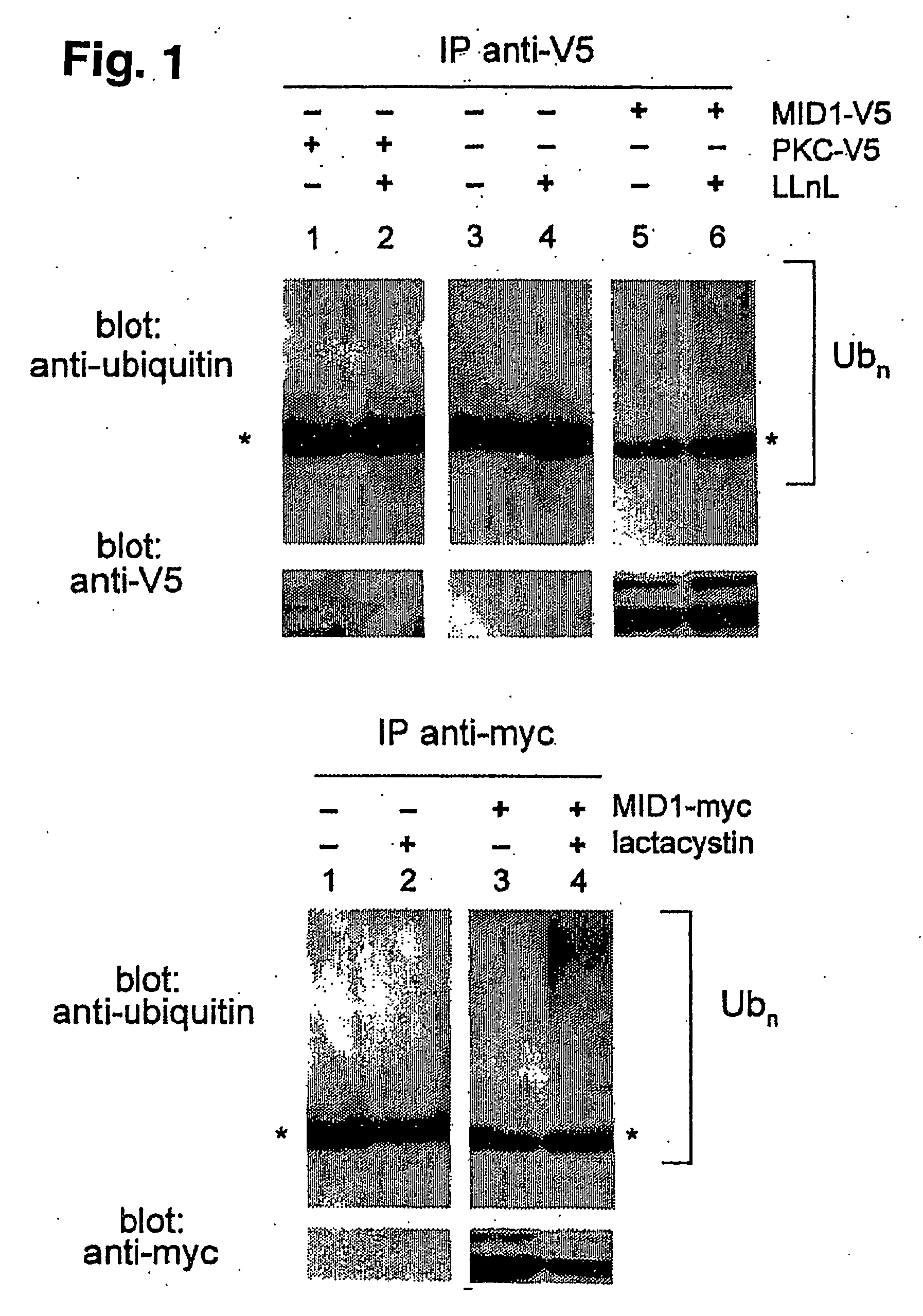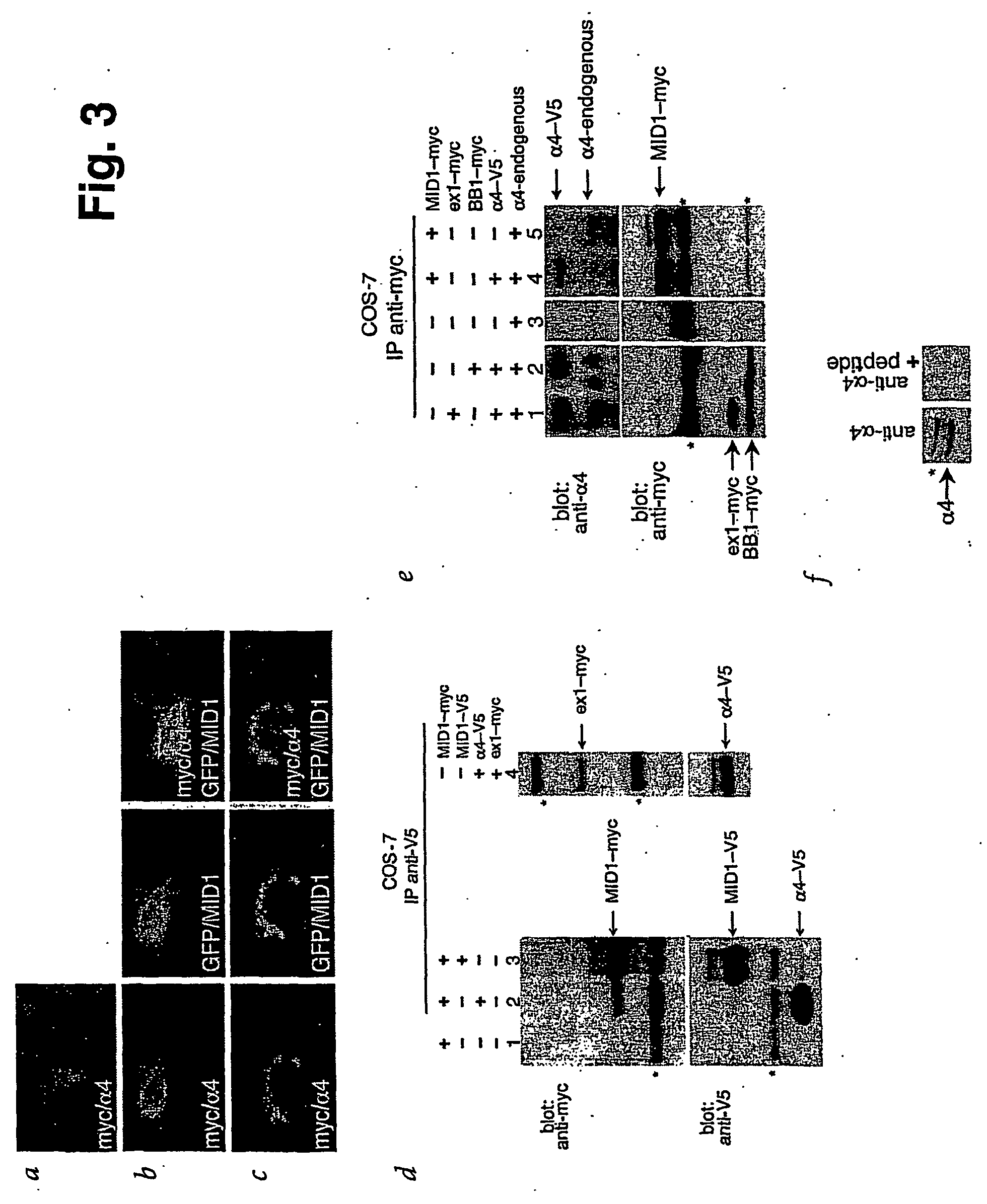Means for use in treating diseases correlated with or caused by non-physiological levels of microtubule-associated pp2ac
a technology of microtubules and pp2ac, which is applied in the direction of instruments, peptide/protein ingredients, drug compositions, etc., can solve the problems of not knowing how the intracellular amount of pp2ac associated with microtubules can effectively be altered, and achieve the effect of dominating negative effect and increasing pp2a activity
- Summary
- Abstract
- Description
- Claims
- Application Information
AI Technical Summary
Benefits of technology
Problems solved by technology
Method used
Image
Examples
example 1
Polyubiquitinated Proteins Accumulate in the MID1 Immune Complex
[0143] Because several RING-finger proteins interact with target proteins and thereby elicit their ubiquitin-dependent degradation8-11, we examined interaction of MID1 with polyubiquitinated proteins. We transfected COS7 cells either with MID1 cDNA or, as a control, with cDNA encoding protein kinase C (PKC), each tagged with a C-terminal V5 epitope or an empty vector, respectively. We treated the cells with 25 μM of LLnL, a proteasome inhibitor, 24 h after transfection to enrich for ubiquitinated proteins. We precipitated cellular extracts with anti-V5 and carried out SDS-PAGE and western blotting with anti-ubiquitin. The MID1-containing precipitate from cells pretreated with the proteasome inhibitor contains copious amounts of proteins ubiquitinated to varying degrees, visible upon immunoblotting as high-molecular weight protein smear (FIG. 1a, lane 6). This protein smear is not seen in precipitates from mock-transfe...
example 2
MID1 Interacts with α4, a Regulatory Subunit of PP2A
[0145] To identify targets for MID1-mediated protein ubiquitination, we used the full-length MID1 protein-coding region as bait in a yeast two-hybrid screen of 106 colonies of a human fetal brain library. We obtained four independent positive clones (a-d) that contained two inserts of different lengths. All clones contain sequences corresponding to the human IGBP1 gene, which encodes α4—a protein previously shown to bind PP2A12,15,16. Clones a and b encode the 168 amino acids (aa) at the C-terminal end, whereas clones c and d contain an N-terminal sequence. After codon 290, this sequence is interrupted by an intron leading to premature termination of translation after 17 additional aa unrelated to α4. Thus, the α4 protein domain that interacts with MID1 maps to the 119 aa common to both types of clones, spanning residues 172-290 (FIG. 2a). FIG. 2c shows the specificity of the MID1-α4 interaction. Of the other proteins tested in t...
example 3
Mapping of the α4 Binding Site on MID1
[0146] MID1 is a multidomain protein harboring a RING finger, two B-boxes, a coiled-coil region, a fibronectin type III domain and a B30.2 domain3—all of which are candidate regions for specific protein-protein interactions. To clarify which domain specifically binds α4, we tested several deletion mutants of MID1 for interaction with α4 in the yeast two-hybrid system. The results show that B-box 1 (residues 110-165) is sufficient for a strong interaction with α4 (FIG. 2b). Indeed, longer constructs including other domains bind less strongly to α4 (FIG. 2a, b).
PUM
| Property | Measurement | Unit |
|---|---|---|
| body weight | aaaaa | aaaaa |
| body weight | aaaaa | aaaaa |
| ionic strength | aaaaa | aaaaa |
Abstract
Description
Claims
Application Information
 Login to View More
Login to View More - R&D
- Intellectual Property
- Life Sciences
- Materials
- Tech Scout
- Unparalleled Data Quality
- Higher Quality Content
- 60% Fewer Hallucinations
Browse by: Latest US Patents, China's latest patents, Technical Efficacy Thesaurus, Application Domain, Technology Topic, Popular Technical Reports.
© 2025 PatSnap. All rights reserved.Legal|Privacy policy|Modern Slavery Act Transparency Statement|Sitemap|About US| Contact US: help@patsnap.com



